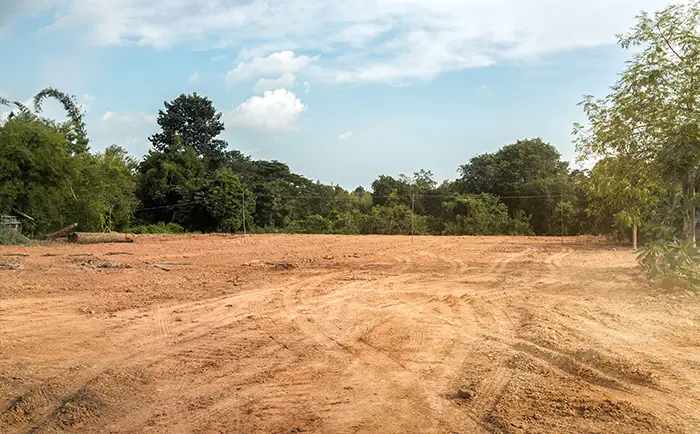Many times, not all of the lots in HOA communities are occupied. And with more vacant lots in HOAs, the more complicated it is for the board to manage.
What are HOA Vacant Lots, Exactly?
When talking about vacant lots in HOAs, there are usually two types to consider.
First are unowned or unsold vacant parcels. These are pieces of land that were never sold during the development phase. They might have been reserved for future development, marked for everyday use, or left untouched.
Second are privately owned vacant lots. These have been purchased but not developed. The owner may be waiting to build, sell, or invest when the time is right.
Each type has different implications in terms of legal responsibility, financial contribution, and appearance.
Legal Considerations: Who’s Responsible for What?
Legal obligations depend on who owns the lot. HOA boards need to know where their authority begins and ends.
For privately owned vacant lots, the rules of the HOA still apply even if no home is built. That means the lot owner is still responsible for paying dues and maintaining the property to community standards.
This includes mowing the grass, removing debris, and addressing dead trees or overgrown areas. If the lot is neglected, the board can issue violation notices and may arrange maintenance at the owner’s expense, depending on the governing documents and state law.
If a lot is still under the developer’s name, the responsibility generally rests with the developer. However, if the ownership is unclear, the board may need legal advice to determine whether the land should be classified as common area or reassigned. Until then, the HOA may have limited power to enforce rules or require upkeep, even if the lot affects the community’s appearance or safety.
Financial Impacts of Vacant Lots in HOA

Vacant land can affect the financial health of a community more than some might expect.
When a lot remains unsold, the HOA collects no assessments from it. This reduces revenue and shifts a greater portion of the financial burden onto other homeowners. In small communities, even a few missing lots can strain the budget.
In cases where the lot is owned but the owner delays or avoids paying dues, the association may face ongoing delinquencies. This can lead to increased legal costs and may impact the HOA’s ability to fund necessary maintenance, repairs, or amenities. Delinquencies also affect cash flow and can compel the board to increase dues for other members.
Maintenance is another concern. If the board chooses to maintain neglected vacant lots to protect curb appeal and safety, that cost may come from the HOA’s budget unless it can be recovered later. This might include mowing, clearing debris, or addressing tree hazards.
There is also the matter of liability. If someone gets injured on a vacant lot and there is any confusion about who owns it, the HOA could be pulled into a lawsuit. This risk is higher if residents commonly use the land for activities or parking.
Appearance and Curb Appeal
A vacant lot that is messy or overgrown can detract from the neighborhood’s appearance. In an HOA community where aesthetics play a significant role in attracting buyers and supporting property values, this can be a serious issue.
Boards should work with owners to make sure vacant lots are kept clean and tidy. That includes mowing, trimming vegetation, and keeping the area free of trash or old materials. If fencing is present, it should be in good repair. Empty lots should not become dumping grounds or storage sites.
Even lots that are not visibly neglected may need attention if erosion or invasive plants start to affect neighboring properties. Regular inspections and proactive communication help reduce these risks.
Can the Community use Vacant Lots in the HOA?
Homeowners sometimes see vacant lots as opportunities for practical or recreational use. This might include parking extra vehicles, setting up a garden, or creating a temporary play area. However, using private land this way can lead to problems.
If a vacant lot is privately owned, the board and residents cannot use it without the owner’s permission. Unauthorized use may lead to disputes, liability issues, or property damage. Even casual parking on an empty lot is risky if there is no agreement in place.
Using vacant land as a community garden or shared space may be possible, but only if ownership is clear and proper agreements are in place. For lots owned by the HOA or designated as common areas, the board can consider formal plans for community use. For other parcels, written agreements, legal review, and insurance considerations are all necessary.
Some lots might be suitable for future amenities, such as walking paths or green spaces, but any long-term plan should begin with confirming ownership and understanding the legal framework.
Strategies for Managing Vacant Lots in HOA

To handle vacant lots effectively, boards should stay organized and proactive. Here are some tips:
- Keep detailed records showing who owns each lot, when assessments are billed, and whether any payments are overdue.
- Maintain regular communication with the lot owners. Friendly reminders can go a long way toward encouraging upkeep and timely dues payments.
- Create clear standards for lot appearance. Apply the same enforcement process used for built properties, including written notices and fines if necessary.
- Review your governing documents. You should also make sure they allow the board to enforce standards on undeveloped lots. If not, consider proposing amendments.
- If the board plans to acquire or convert lots for shared use, work with legal counsel to ensure a smooth process.
- Monitor lots for safety concerns and document any actions taken by the board. This helps reduce liability in the event of disputes that may arise later.
- Additionally, consider partnering with landscape professionals for seasonal clean-ups or routine maintenance on neglected lots.
Turning Empty Lots Into Community Assets
Vacant lots in HOAs do not have to be a liability. With good records, fair enforcement, and a clear strategy, the board can minimize financial risk and maintain the neighborhood’s appearance. In some cases, those empty parcels could even become the foundation for future amenities that benefit the entire community.
Looking for help in managing vacant lots in your Florida community? Freedom Community Management provides HOA management services in Florida. Call us at 904-490-8191 or contact us online to learn more!


